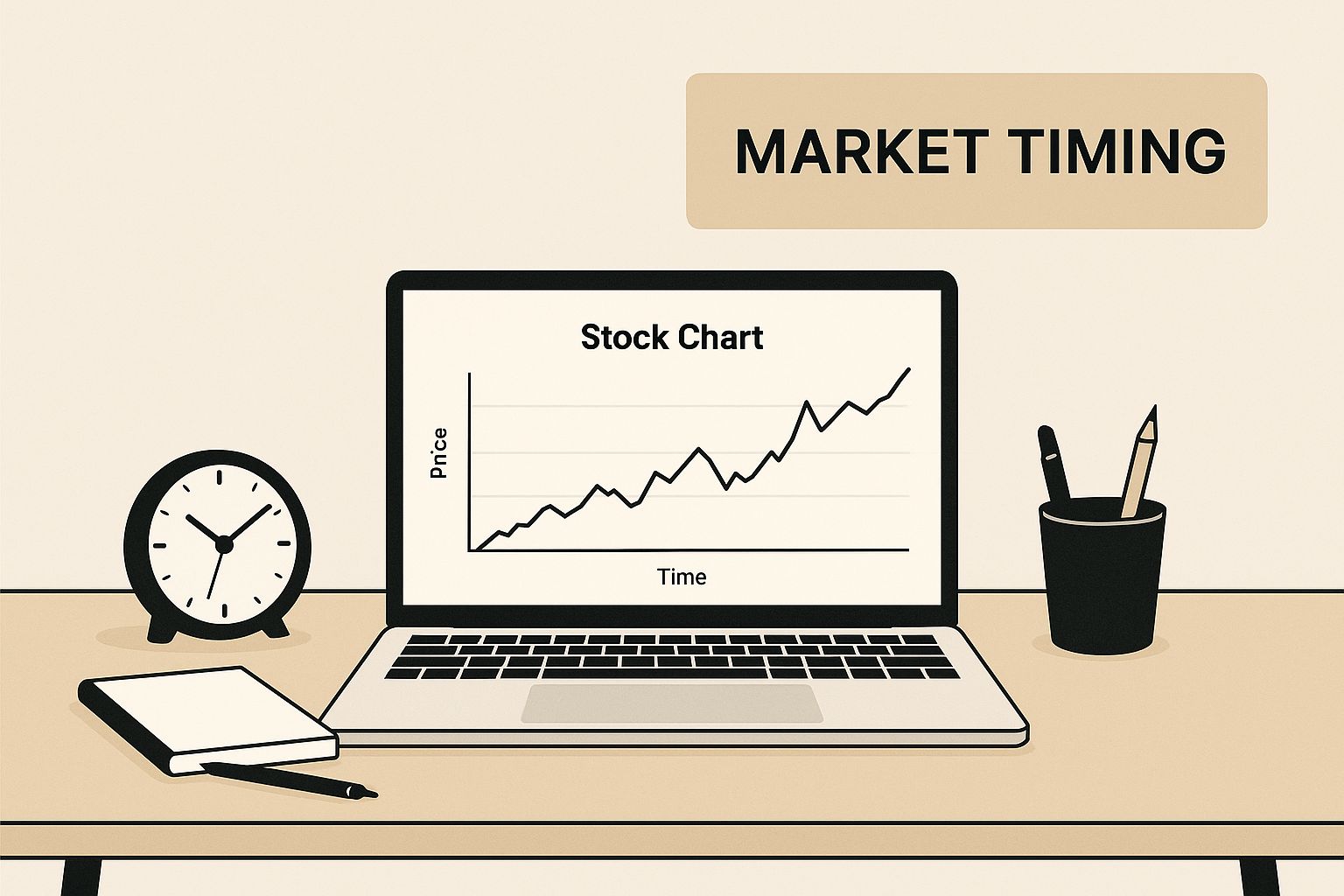Let’s be honest: who hasn't dreamed of buying a stock right at the bottom and selling it at the absolute peak? That’s the seductive promise of market timing. It’s an active investment strategy that tries to predict where the market is headed next.
Think of it like a professional surfer. They don't just paddle out and ride every little ripple. Instead, they study the ocean, wait for the perfect wave to form, and then ride it for all it's worth. A market timer does the same, aiming to jump in right before an uptrend and get out just before a downturn.
What Is Market Timing Explained
At its core, market timing is the polar opposite of the classic “buy-and-hold” philosophy. Buy-and-hold investors stick with their investments through thick and thin, trusting that time will smooth out the bumps. Market timers, on the other hand, believe they can do better by actively dodging the downturns and catching the upswings.
But here’s the catch: to succeed, you have to be right not just once, but twice. You need to know exactly when to sell before a drop and when to buy back in before the market recovers. If you get the timing wrong on either end, you can easily end up worse off than someone who just sat tight.
This infographic captures the essence of a market timer at work—poring over charts and data, trying to make that critical call.

The image really drives home the analytical, high-stakes nature of trying to forecast the market's next move.
To see just how different these two approaches are, let's break them down side-by-side.
Market Timing vs Buy-and-Hold Investing
| Aspect | Market Timing | Buy-and-Hold Investing |
|---|---|---|
| Philosophy | Actively predict market moves to buy low and sell high. | Passively hold assets for the long term, ignoring short-term volatility. |
| Activity Level | High. Involves frequent trading based on forecasts. | Low. Minimal trading, focused on long-term growth. |
| Goal | Maximize short-to-medium term gains and avoid losses. | Build wealth steadily over years or decades. |
| Risk | High risk of mistiming the market and missing out on gains. | Market risk; the value of investments can decline over time. |
| Requirement | Requires extensive analysis, skill, and a bit of luck. | Requires patience, discipline, and a long-term perspective. |
Ultimately, the choice between these strategies comes down to your own goals, risk tolerance, and how much time you're willing to dedicate to managing your portfolio.
The Core Challenge of Prediction
The allure of market timing is obvious—perfectly executed, it offers incredible rewards. You'd capture all of the market’s gains while sidestepping every single loss. But in the real world, this is one of the hardest games to play. Markets are notoriously unpredictable, swayed by everything from economic data to sudden geopolitical events.
The challenge isn't just being right once; it's being right consistently. The strategy's success hinges entirely on the accuracy of its predictions, making it a high-stakes game.
Even the pros find it nearly impossible to time the market successfully over and over. What makes it so tough? Some of the market's best days often happen right after its worst days. If you sell to avoid the pain, you're at huge risk of missing the powerful rebound that follows. This is why the debate over "timing the market" versus "time in the market" is, and will likely always be, a central theme in investing.
The High-Stakes Game of Timing the Market
Market timing is the holy grail of investing. It’s the dream of buying at the absolute bottom and selling at the very peak, sidestepping every painful downturn while capturing all the gains. It’s an incredibly powerful idea, promising legendary returns.
But it’s also a notorious double-edged sword.
For every investor who gets it right, there’s another who gets it spectacularly wrong. History is littered with both. John Paulson famously pocketed $15 billion by timing the 2008 housing market collapse. Peter Lynch pulled off a 29% annual return at the Fidelity Magellan Fund from 1977 to 1990 using sharp, tactical moves.
Then there’s the other side of the coin. Bill Miller’s Legg Mason Value Trust lost a staggering 55% in 2008 on bad calls. And who can forget Long-Term Capital Management, which blew up in 1998, losing $4.6 billion after their timing bets went south. You can get more details on these famous wins and losses at TradeFundrr.com.
The Psychology Behind the Gamble
So, what makes timing the market so incredibly hard? It’s not just about crunching numbers or reading charts. It's a full-on battle against your own brain. Two emotions are constantly working against you:
- Fear of Missing Out (FOMO): The market is ripping higher, and everyone you know is making money. FOMO screams at you to jump in before it’s too late, often right at the market top.
- Panic Selling: The market tanks, and your portfolio is bleeding red. Your gut instinct is to sell everything to stop the pain, which often means locking in losses right at the bottom.
This emotional rollercoaster is why even the pros get it wrong. Nailing market timing requires more than just good analysis—it demands the ice-cold discipline to go against the herd and your own instincts.
The real challenge is that you have to be right twice. You have to know when to sell, and then you have to know exactly when to jump back in. Miss just one of those calls, and you can wipe out your gains or even make your losses worse.
It’s a brutal game. The market’s best days often happen right after its worst, so being on the sidelines for even a short time can crush your long-term returns. This is precisely why most financial experts will tell you to be extremely careful and stick with strategies that don't depend on predicting the unpredictable.
Key Strategies for Market Timing

So, how do traders actually try to get ahead of the market’s next big swing? While there's no magic crystal ball, a few core strategies have become the go-to playbooks for timing the market.
Think of these as different lenses for viewing the market. Each one focuses on a unique set of clues, from cold, hard price data to the emotional pulse of the crowd.
Technical Analysis: The Chart Detective
Technical analysis is all about playing detective with price charts. The core belief here is simple: all the news, earnings reports, and hype are already baked into an asset's price. So, instead of reading headlines, technical analysts read charts.
Their job is to hunt for patterns and trends in historical price action and trading volume that might give away the next move.
They have a whole toolkit to help them find these clues:
- Moving Averages: These smooth out the chaotic day-to-day price swings to reveal the true, underlying trend. To really get a handle on them, check out our guide on how to use moving averages.
- Support and Resistance Levels: These are key price zones where buying or selling pressure has historically shown up, causing prices to bounce or get rejected.
- Chart Patterns: Formations like the classic "head and shoulders" or a "double bottom" can act as road signs, signaling that a trend is about to reverse or power ahead.
At its heart, this strategy is built on the idea that market history, driven by predictable human psychology, tends to repeat itself.
Fundamental Analysis: The Business Investigator
If technical analysts are chart detectives, then fundamental analysts are old-school business investigators. They couldn't care less about short-term squiggles on a chart. Their entire focus is on figuring out an asset's intrinsic value.
Fundamental analysts roll up their sleeves and dig into the nitty-gritty of a company's health or the broader economy. Their bet is that, sooner or later, an asset's market price will find its way back to its true, underlying worth.
This means poring over everything from earnings reports and debt levels to the quality of a company’s management team. They’re looking for a bargain—to buy assets trading for less than they're truly worth and sell those that have gotten way ahead of themselves.
Sentiment Analysis: The Mood Reader
Finally, we have sentiment analysis, which is all about reading the room. This approach tunes into the collective mood of the market, gauging whether investors are overwhelmingly fearful or dangerously greedy.
The idea is that powerful emotions can shove prices far away from their fair value, and that's where the opportunity lies.
Tools like our own Fear & Greed Index are designed to measure this emotional temperature. A sky-high "Fear" score might mean everyone is panicking, which could be the perfect time to buy. On the flip side, a reading of "Extreme Greed" might signal a bubble is brewing, suggesting it’s time to be cautious. It's the ultimate contrarian play: you buy when others are scared and sell when they're euphoric.
Using Seasonal Trends to Time the Market
Forget charts and balance sheets for a second. Some investors swear by a different force to guide their timing: the calendar. This is the world of seasonal investing, a strategy built on the simple idea that markets often follow predictable patterns throughout the year.
The most famous example is the old Wall Street adage, "Sell in May and Go Away." The saying suggests that the six months from November to April have historically delivered much better returns than the May to October stretch. The goal is to sidestep the weaker summer months and jump back in for the traditionally stronger end-of-year rally.
Do Seasonal Patterns Actually Work?
History does show some interesting patterns. Look back over the last couple of decades, and you'll see the S&P 500 often performs well in months like April, November, and December. On the flip side, September has earned a reputation for being a particularly weak month. If you want to dive into the data yourself, you can explore detailed seasonal stock market patterns across the major indices.
But before you clear out your portfolio every May, remember that relying on these trends alone is a very risky game. Here's why:
- Averages Hide Volatility: A few fantastic years can easily skew the average, masking all the times the pattern completely failed to show up.
- No Guarantees: Past performance is never a crystal ball for future results. A major economic shift or a global event can throw a decades-old trend right out the window.
Ultimately, seasonal trends are just one piece of a much larger puzzle. They offer valuable context but should never be your only guide.
Think of it like a weather forecast. You know it’s likely to be sunny in July, but you'd still check the daily forecast before leaving your umbrella at home. In the same way, understanding these seasonal cycles can be a great supplement to other strategies. To learn how to weave different analytical approaches together, check out our guide on how to analyze market trends for smarter investing.
Why Time in the Market Beats Timing the Market

It’s a classic fear that paralyzes countless investors: what if I put my money in right before a huge market crash? That worry keeps a lot of people on the sidelines, waiting for the “perfect” moment to jump in—a moment that, frankly, rarely ever arrives.
But here’s what decades of market history tell us: consistency almost always wins over trying to be a perfect timer. The power of compound growth over the long haul has a way of smoothing out the scary dips and bumps. This simple but powerful idea is the bedrock of the old investing adage: time in the market beats timing the market.
The Surprising Truth About Investing at All-Time Highs
It feels completely wrong, doesn't it? Buying when the market is at its absolute peak sounds like a recipe for disaster. But the data tells a different story. More often than not, an all-time high is a sign of market strength and momentum, not a cliff's edge.
Think about it this way: for the market to go up over time, it has to constantly hit new highs. Looking at the S&P 500 from 1958 to today, there were 13 instances where the index hit a new high after being down for a while. In 12 out of those 13 times, the market was even higher one year later, with an average gain of a whopping 15.3%. It turns out new highs are often just another step in a long, healthy uptrend.
The real risk for most of us isn't buying at the top. It's sitting in cash and missing out on the market's best days, which often pop up right after periods of fear and uncertainty.
This is exactly why strategies like dollar-cost averaging are so effective. Instead of trying to guess the lows, you just invest a set amount of money at regular intervals. This disciplined approach means you naturally buy more shares when prices are down and fewer when they're up, taking all the emotion and guesswork out of the equation.
If you want to learn more about this hands-off approach, check out our guide on what is dollar-cost averaging and how it works. It's a fantastic way to build wealth without losing sleep over the market's every move.
So, Should You Try to Time the Market?
We've walked through the strategies, the risks, and the tantalizing rewards. Now we get to the big question: Is market timing actually a good idea for you?
There’s no easy yes or no here. The right answer comes down to your personality, your financial situation, and what you’re trying to achieve.
Let's be blunt: market timing is a tough game. It’s a high-risk, high-reward strategy that demands serious skill, a ton of research, and nerves of steel. This isn't a "set it and forget it" approach; it's an active, hands-on mission to predict the unpredictable. Before you even think about diving in, you need to have an honest conversation with yourself.
Know Your Investor Profile
Start by looking in the mirror. How are you wired as an investor and what does your life look like?
- What’s your real risk tolerance? Are you genuinely okay with the possibility of big losses if you get a call wrong?
- How much time can you commit? Successful timing isn’t a weekend hobby. It requires you to constantly have a finger on the market’s pulse.
- Can you master your emotions? Will you hit the panic button and sell everything during a dip? Or will FOMO make you chase a rally right at its peak?
Answering these questions honestly is your first filter. For most people, the stress and the odds are just too high. A patient, long-term "time in the market" approach is a much better fit for their financial journey. At the end of the day, the best strategy is the one you can actually stick with.
Got Questions About Market Timing?
Even after getting the hang of the strategies and risks, a few questions about market timing always seem to pop up. Let's clear the air and tackle some of the most common ones.
Is Market Timing Illegal?
Nope, market timing is not illegal. It’s a perfectly legitimate investment strategy.
The term got a bad rap back in the early 2000s when some mutual funds got caught up in scandals. They were letting certain big-shot investors make trades after the market closed at that day's price—a practice called late-trading, which is definitely illegal. But what individual investors do to time their entries and exits? Totally legal.
How Is Market Timing Different from Day Trading?
While both are hands-on approaches, they play in completely different timeframes.
Day trading is all about speed, involving buying and selling stocks, crypto, or other assets within the same day. The goal is to profit from tiny, fleeting price changes. Market timing, on the other hand, plays the long game. A market timer might hold a position for weeks, months, or even longer, aiming to catch the big waves—major market trends and cycles—not the small daily ripples.
Think of it this way: Day trading is a sprint measured in minutes and hours. Market timing is a marathon focused on navigating the major cyclical shifts that unfold over a much longer period.
Can You Actually Time the Market Successfully?
It's possible, yes, but pulling it off consistently is incredibly tough.
History is full of legends who made famous calls, but for every big win you hear about, there are countless investors who got it wrong. Nailing one prediction is one thing. But calling both the top and the bottom over and over again? That takes a rare mix of skill, guts, and a whole lot of luck. For most of us, a steady, long-term strategy usually wins out.
Ready to see what the market is really thinking before you make your next move? The Fear Greed Tracker gives you real-time sentiment scores on over 50,000 assets, so you can stop guessing and start making smarter, data-driven decisions. Turn market emotion into your edge by visiting https://feargreedtracker.com to start tracking today.
